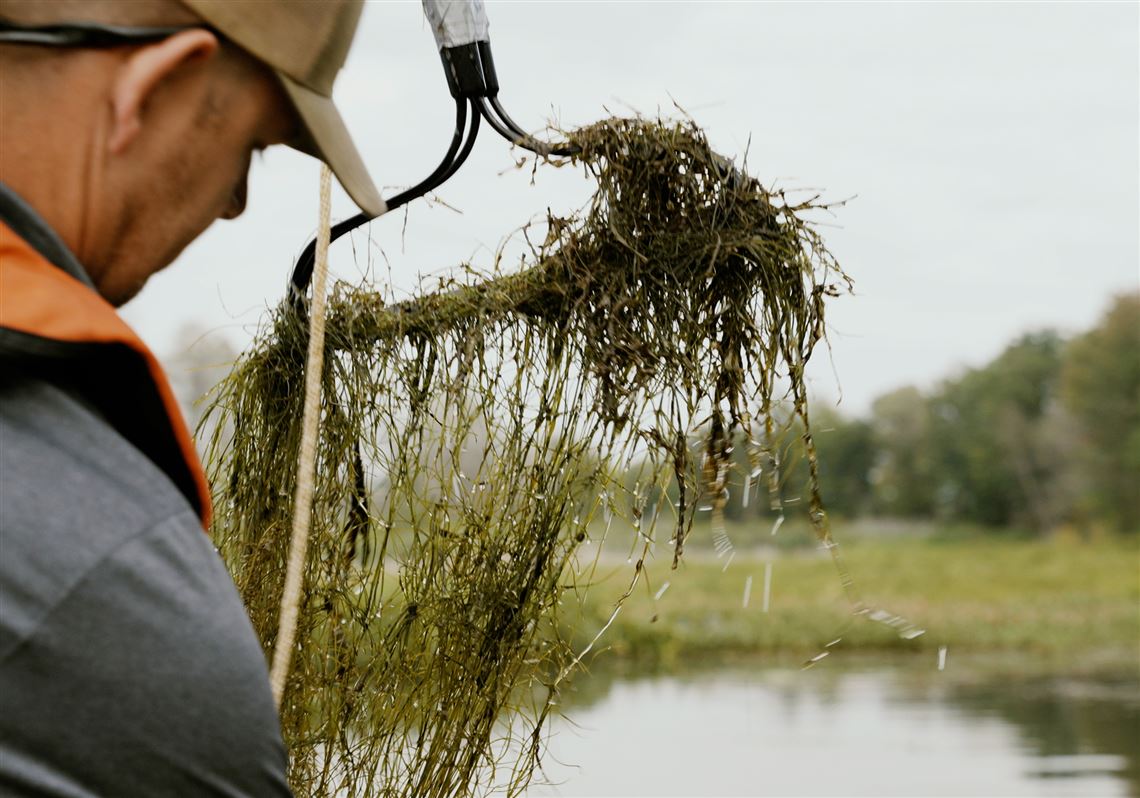Lurking in the steel blue waters of Lake Erie and its marshes, a green mat of vegetation suffocates native plants with its fast-growing layers of tangled fiber.
Some fish swim the other way.
The more than 4 million annual visitors to Presque Isle State Park don’t see the underwater battle waged against starry stonewort, an invasive alga that is well established there.
The state park regularly eradicates at least six species of aquatic plants in select sections so kayaks and other boats can access the main channel in the lagoon system and boat launches of this National Natural Landmark.
Starry stonewort arrived in the Great Lakes accidentally from Eurasia in the 1970s from the discharge of cargo ship ballast water.
While many people are familiar with the invasive zebra mussel, there are at least 145 invasive species at Presque Isle documented by Pennsylvania iMapInvasives. The app is free and available from the Pennsylvania Natural Heritage Program for the public to identify and report invasives.
Presque Isle’s 145 invasive species include 121 plants, one alga (the starry stonewort), and 23 species of animals — fish, snails, turtles, worms, mussels, a clam, a crayfish, an amphipod, a bird and an insect.
Invasive plants and wildlife displace and prey on natives and often proliferate because they have no natural enemies.
A new short film, “Seeing The Unseen: Aquatic Invaders And What's At Stake,” is available online and a special screening at the University of Pittsburgh is set for Oct. 1. (A Great Lakes Media & Film production)
The documentary produced by the Western Pennsylvania Conservancy features breathtaking drone videos of Pennsylvania’s most visited park and some of the state’s most biologically diverse areas: Presque Isle State Park in Erie, and French Creek and Lake Pleasant in the northwestern part of the state.
All three sites are home to some of the state’s rarest and endangered species.
In one of the film’s most interesting moments, biologists hand-wipe single blades of non-native narrowleaf cattail and its hybrid with herbicide. The one-blade-at-a-time approach prevents damage to nearby native plants.
While the narrowleaf cattail has invaded other wet habitats, the Conservancy took on the painstaking task at Lake Pleasant to eradicate it while preserving native plants at one of the state’s most pristine glacial lakes.
“I wanted to make people less blind and see the problem for themselves,” said Amy Jewitt, Pennsylvania iMapInvasives program coordinator for the Conservancy and one of the film’s executive producers.
The documentary comes at a time when many invasive species have already reached a critical point years ago, brought in by boat, seeds and plant materials on shoes, clothing and fishing gear.
Compounding the problem, people sometimes dump pets that have grown too large. Presque Isle State Park is overrun with red-eared slider turtles, the most popular pet turtle.
“They can grow incredibly large and outcompete other species,” Jewitt noted.
The film introduces only a handful of invasive species, “so people can wrap their heads around it and raise their level of caring,” she said.
How you can help
The documentary has a small ask for the public to stem invasives: Don’t dump pets or live bait, and clean your boats, hiking shoes and gear.
The state Fish & Boat Commission stepped in with a new regulation in January requiring boaters to clean off their boats after exiting a body of water. Carrying out just one piece of invasive algae or an aquatic snail is enough for it to take off in another waterway.
“Essentially you cannot have vegetation attached to your boat or trailer and drain the ballast water and live well," said Mike Parker, communications director for the Fish & Boat Commission.
“It’s another part of your boating checklist like having life jackets and lights at night,” he said.
The Commission is focusing on educating boaters, not issuing citations unless a case involves a repeat offender, he said.
“Mostly everyone at this point has seen the impact of invasive species in Pennsylvania,” Parker said.
In the spring, anglers enjoy the open banks of state park lakes. But as summer goes on, those areas become unfishable because of aquatic vegetation, which is, in most cases, invasive species.
Invasive aquatic vegetation doesn’t provide nutrients during decomposition like native plants do, Parker added.
“Everything is related to the spreading of aquatic plants. It affects macroinvertebrates that impact the minnow and game fish. You have to think about the cycle,” Parker said.
Also, anglers should dispose of leftover live bait; not throw it in the water. It’s unlawful to introduce a non-native fish species into the wild.
The Conservancy is concerned about keeping the round goby, an aggressive, invasive bottom feeder, from penetrating too far into French Creek, which is featured in the documentary.
From Europe's Black and Caspian Seas, the round goby outcompetes native species such as sculpin, logperch, lake trout and darters.
“The path is there for them to make it to the Allegheny River if they could. You don’t want that,” Parker said.
So many species, so little time
“A lot happens behind the scenes, a lot of things people aren’t aware of,” said Holly Best, assistant park manager at Presque Isle State Park.
At Presque Isle, a woody invasive vine from East Asia, round leaf bittersweet, has stems that can grow 60 feet long and reach 4 inches in diameter.
It climbs and girdles trees and shrubs, cutting off nutrients and water, weakening and killing them.
In addition to dealing with invasives, park staff educates the public to prevent the spread.
Sometimes people like pretty invasives like phragmites (common reed) and will ask Presque Isle's park staff where they can buy them to put in their home gardens.
“People believe if it’s green, it’s good,” Best said. “They don’t realize it’s causing a problem.”
Park staff and volunteers battle invasives pretty much under the radar of the general public.
“We don’t want to interrupt people (while they are recreating) when we do this work,” Best said.
The continuing battle may not end in a total victory, but there is progress. Some native plants have returned after the invasives are controlled, Best reported.
At this point, Presque Isle staff manage invasives; they can’t eradicate them.
“We don’t do anything with starry stonewort. It’s already prolific. When you apply a herbicide, it burns off the top of the plant but doesn’t kill it,” Best said.
The park has worked with nonprofits such as Ducks Unlimited, the Regional Science Consortium and other sources for grants to pay to remove multiple invasive species.
In the summer, targeted invasive species along the water’s edge include phragmites, purple loosestrife, flowering rush and yellow iris. Other targets include round leaf bittersweet, invasive honeysuckle, reed canary grass, mullein, white sweet clover, Japanese knotweed, privet, burning bush, European birch and tree of heaven.
An invasive monculture
“Those are our heavy hitters. They are prevalent in the landscape,” Best said.
If left unchecked, those plants could quickly take over, choke out native vegetation and create a “monoculture” of invasive plants.
It’s a particular problem at Presque Isle, whose sandy shoreline and unique environment support rare and endangered plants, Best said.
Environmental groups like the Conservancy are working on a state initiative to rally funds consistently to continue work on tamping down invasives.
It’s not that there isn’t funding – but grants can be restrictive and sporadic.
A lapse in funding slows down the continued efforts needed to beat back invasive species, which can take years.
“You can’t stop the clock on invasives,” Jewitt said.
Mary Ann Thomas: mthomas@post-gazette.com
First Published: September 5, 2024, 9:30 a.m.
Updated: September 6, 2024, 1:59 a.m.


















